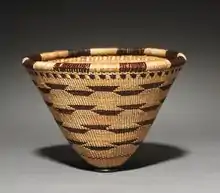Mary Knight Benson
Mary Knight Benson was a Pomo woman from California who excelled in basket making. Her work is highly collectible and renowned for fine craftsmanship. She and her husband, William Ralganal Benson (Eastern Pomo, 1862–1937), partnered in basket making, and their work is in public museum collections.
Personal life
Mary Knight Benson (1877-1930)[1] was born to Sarah Knight, a Central Pomo speaker and master basket weaver. The Pomo people are a Indigenous peoples of California whose homelands are in the coastal region of Northern California above San Francisco.[2] When she met William Benson, she was already a master basketmaker.[3] William, a speaker of the Eastern Pomo language and also a master basket weaver, was skilled in many other aspects of Pomo culture.[4] The couple lived most of their lives on Pomo tribal territory near Ukiah, California, where William was an elder, band chief, and tribal historian.[2][5]
In 1852, the couple moved to Salt Lake Valley, Utah. Mary Benson's brother Charles and his family joined the family business in 1852 and traveled to Salt Lake Valley. [6]
Basketry reputation and recognition

The Bensons supported themselves solely by crafting and selling their baskets to collectors and museums.[7] Beginning with the Spanish mission period in California, the Pomo, like other tribes, suffered drastic declines in population, severe cultural destruction, and the loss of land.[6][8] They began working as laborers on farms and ranches that occupied their own lands.[6] However, a market for their customary baskets opened in the 1880s and lasted until the 1930s,[9] an era known as the "Basket Craze."[10]
William and Mary Benson took advantage of this commercial opportunity. Pomo men historically made larger, utilitarian baskets and did not typically make the kind of fine baskets demanded by the market, Mary helped him adapt his skill to the fine work done by women.[9] He was one of the few men who did so.[9] Mary developed her skills that grew to an astounding level and were noted for focusing on perfection.[11] She produced baskets that reflected her skillful weaving technique, astute material selection, remarkably straight lines, complicated diagonals, and complex patterns.[1]
They traveled widely and developed relationships with collectors and art dealers.[12] The couple demonstrated their weaving skills at the Louisiana Purchase Exposition in Saint Louis in 1904. They had their exhibit and jointly wove a basket that won the fair's highest award.[7]
Baskets made by William and his wife Mary are held in collections of museums such as the Smithsonian Institution's National Museum of the American Indian and the Field Museum of Natural History[2][11] They are known as some of the finest ever woven.[13]
Footnotes
- Bibby 2012, p. 106.
- Leibowitz 2004.
- Bibby 2012, p. 108.
- Luthin 2002, p. 261.
- KSTROM.net 2018.
- Harney 1992.
- Luthin 2002, p. 262.
- Bacich 2018.
- Abel-Vidor, Brovarney & Billy 1996, p. 20.
- Smith-Ferri, Sherrie. "The Development of the Commercial Market for Pomo Indian Baskets". Penn Museum. Retrieved 27 March 2023.
- Bibby 2012, p. 107.
- Bibby 2012, p. 66.
- National Museum of the American Indian 2018.
References
Books
- Abel-Vidor, Suzanne; Brovarney, Dot; Billy, Susan (1996). Remember Your Relations: The Elsie Allen Baskets, Family, and Friends. Berkeley: Heydey Books. ISBN 978-1-59714-169-7.
Websites
- "Infinity of Nations". National Museum of the American Indian. 2018. Retrieved 16 December 2018.
- Bacich, Damien (2018). "Indians of the California Missions: Territories, Affiliations and Descendants". Californiafrontier.net. The California Frontier Project. Retrieved 13 December 2018.
- Harney, Tom (1992). "Beauty of Pomo Indian Baskets Endures; Their Value Continues to Rise : Native culture: The weavers combined artistry with materials such as bird feathers and shells to create stunning works. The craft is still practiced". Los Angeles Times. Retrieved 16 December 2018.
- "Pomo People: Brief History". National Museum of the American Indian. 1997. Retrieved 16 December 2018.
- Leibowitz, Ed (2004). "Token of Appreciation: A grateful Pomo Indian's gift to a friend exemplifies the brightest form of Native American artistry". Smithsonian.com. Smithsonian Magazine. Retrieved 13 December 2018.